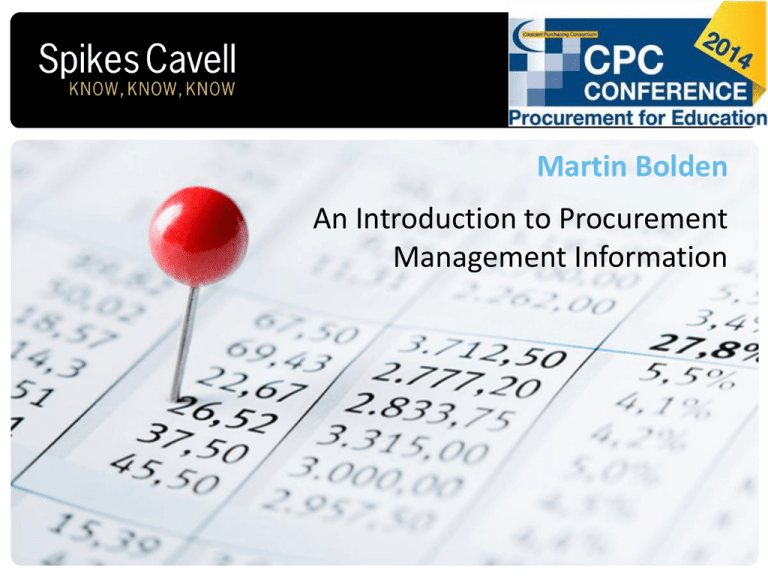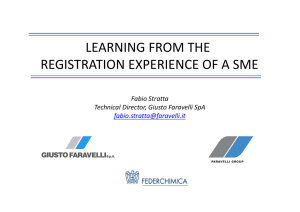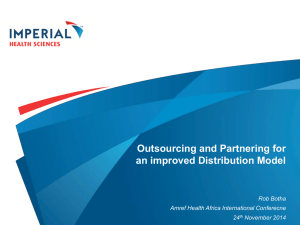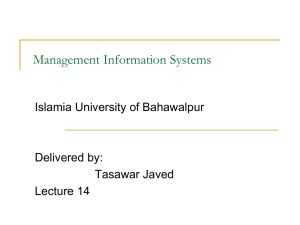presentation
advertisement

Conference Title Date Martin Bolden An Introduction to Procurement Management Information IN THE SPIRIT OF TRANSPARENCY… PROCUREMENT MANAGEMENT INFORMATION • • • • • • Why are we doing this? What problem are we solving? Is this actually useful? Who is it useful to? Will this change behaviour? Is there an easy way? How many people in the How many of you found questions roomAsk have conducted a it useful? spend analysis in the last year? WHY BOTHER DOING SPEND ANALYSIS? • You’re likely being asked to cut spending, but not services. • Increased pressure to collaborate internally and externally • Concern with local/small/ sustainable suppliers • Spend transparency or FoI TAKE ACTION Spend analysis has little value as an intellectual exercise. When it is used as a strategic business tool it becomes a key enabler for change. HAVE A GOAL IN MIND • Manage spend more strategically • Manage spend activity more efficiently • Change buyer behaviour • Increase spend under contract • Procure sustainably • Buy collaboratively • Deliver savings WHAT DO YOU NEED TO ANALYSE? • • • • • Your supplier base Your spend categories Common suppliers (Non) Contracted spend Commodity detail DATA SOURCES • What sources of data are readily available to you? – – – – Accounts Payable PCard Purchase Orders Contracts • Think about how complete a picture is necessary to achieve your goal THE FIVE PIECES OF DATA YOU NEED TO GET STARTED 1. 2. 3. 4. 5. Supplier Name Supplier Address Transaction Number Transaction Date Transaction Value Transforming Data into Information • Data: – raw, unorganised facts that need to be processed. Data can be something simple and seemingly random and useless until it is organised. • Information: – When data is processed, organised, structured or presented in a given context so as to make it useful, it is called Information. Source: http://www.diffen.com/difference/Data_vs_Information WHAT YOU DO TO THE DATA… Implement a repeatable process if you want to track performance over time! Cleanse Spend M.I. Classify Enrich THE TYPICAL APPROACH TO INHOUSE SPEND ANALYSIS Export spend data from all systems Combine data exports Sense check combined data Manipulate in Excel Enhance vendor information (largest suppliers) Manually classify suppliers/spend IF YOU USE A THIRD PARTY, YOU SHOULD EXPECT Export spend data from all systems Standardise exported data Check fitness/accuracy of data exports Validate exports with you Enrich vendor information with third party data Validate classifications Classify vendors/spend to a common taxonomy De-duplicate supplier records Group common suppliers across datasets Provide MI tools with pre-built reports POTENTIAL SOLUTIONS Software Focused • Financial system reporting tools • Analytics/BI tools Data Focused • Spend analysis service provider • Hire a data analyst (or two) Guidance Focused • Customised consultancy project WHAT CHALLENGES MIGHT YOU FACE? • Raw data is frequently incomplete and of poor quality • Access to data may be difficult • Multiple and poorly integrated systems (AP, pCard etc.) • Time, skilled resources and support may be lacking KNOW WHAT YOU ARE GETTING INTO AT THE BEGINNING • • • • • Software tools are not automatic. Accurate classification is not easy. Data will arrive in many formats. Data must be checked for errors. Access to the raw data isn’t necessarily straightforward. • Secure the support you need. • Get a set of tools you can use or learn to use the ones you have. WHAT THE INFORMATION CAN FACILITATE Improve Processes Change Buyer Behaviour Manage Supplier Relationship Manage Risk Recover Overpayments Buy Collaboratively Support more SMEs Source More Locally Ensure Legal Compliance Benchmark Relative Position Evidence Success Deliver Savings Spend Data WHO COULD USE THE INFORMATION? Procurement Buyers Procurement Managers Contract Managers Finance Department Budget Holders Department Heads Buyers Spen Spend d Data Data Accounts Payable Audit/Legal Departments Diversity Program Manager Economic Development Environmental /Sustainability Officers EXAMPLES OF SPEND MANAGEMENT PROJECTS Finding Savings Invoice 1 Consolidation Long Tail Consolidation 2 Improved Terms 3 Category Extension 4 Category Rationalisation 5 Compliance, Contracted Suppliers 6 7 Category Reengineering 8 Collaboration INVOICE CONSOLIDATION • Which suppliers should I seek weekly/monthly invoices from? • Which categories of suppliers are giving me an invoice volume problem? • Which suppliers would be best to move order and payment to pCard? • How much could I save by moving to pCard? Aggregate number of invoices per supplier Supplier Names Average invoice value per supplier £ Invoices by value range per supplier INVOICE CONSOLIDATION • 5,457 invoices were processed where the value of the invoice was less than £50. LONG TAIL CONSOLIDATION • • • • Which suppliers do I spend less than £1,000 per year with? Which suppliers do I only have one transaction with per year? Which departments are using a lot of ‘one off’ suppliers? Which categories do we have a lot of small suppliers in? Aggregate spend per supplier Supplier Name Aggregate number of invoices per supplier £ Category of supplier Department spend per supplier LONG TAIL CONSOLIDATION • 935 vendors where less than £1,000 was spent in a 12 month period. That’s 55.92% of the vendors, but only 1.68% of expenditure. MANAGE STRATEGIC SUPPLIERS • Which suppliers do I spend the most with and how many departments do they supply? • How many other suppliers are in the same category as my top tier suppliers? • Are all of my departments getting the same “best rate?” • How much do my top tier suppliers rely on my business? • How dependant am I on a supplier? Category of supplier Department spend per supplier Aggregate spend per supplier (deduplicated) Supplier Name Other suppliers in the same category Percentage of supplier’s turnover represented £ Contracts already in place MANAGE STRATEGIC SUPPLIERS • 61.79% of this college’s spend is with the top 20% of suppliers (125) CATEGORY RATIONALISATION/ CATEGORY EXTENSION • Which suppliers enjoy a relative monopoly of supply to my organisation? • Which categories do I have too many suppliers in where aggregation could drive costs and prices down? • What contracts are coming up for renewal where I could rationalise or extend my supplier base? Other suppliers in the same category Category of supplier Aggregate spend per supplier Supplier Name Department spend per supplier £ Current contract expiry date CATEGORY RATIONALISATION/ CATEGORY EXTENSION • 11 Printing Services Providers one large, 2 medium and 8 small. COMPLIANCE, CONTRACTED SUPPLIERS • Which departments aren’t using the preferred/ contracted supplier in a given category? • Which categories of spend don’t have any contracts in them? • Are there instances where we spend more than was on the original contract? • Is my data source up to date enough to deal with offcontract spend quickly? Category of supplier Other suppliers in same category Dept. spend per supplier Aggregate spend per supplier Supplier Name Current contracts Categories with no contracts £ Monthly spend data COMPLIANCE, CONTRACTED SUPPLIERS • 36% on average spent with contracted suppliers. COLLABORATION, COMMON SUPPLIERS • Which suppliers does my group already share and how much is spent with those suppliers? • Which categories does the group have the greatest spend/ greatest number of suppliers? • When are the current contracts for members of the group expiring so that we can collaborate? Aggregate spend per supplier) Category of supplier to common classification Standardised public sector body name/number Standardised supplier name/number Current contract expiry date Centrally hosted and maintained database £ Common tools that all contributors can use COLLABORATION, COMMON SUPPLIERS & SPEND • There are 16 suppliers who supply all 4 colleges, with a cumulative spend of £3.5m. 62 suppliers provides goods and services to 3 colleges who spend £12.2m with them. ANALYSIS SOFTWARE • Analysis tools are simply there to assist you in your search to extract valuable information and direction from data. • The greatest tools can only deliver limited information if the data they are analysing is incomplete or inaccurate ANALYSIS SOFTWARE • The #1 impediment to information management success? – Accessing relevant, timely or reliable data. Source: Information Week – November 2013 CONCLUSION • Have objectives in mind • Spend Analysis is really the first step – Get the data in shape first QUESTIONS/THOUGHTS/COMMENTS FOR MORE INFORMATION For more details about how Spikes Cavell can help you to transform your data into valuable spend management information contact : Martin Bolden 07500 081425 martin.bolden@spikescavell.co.uk







